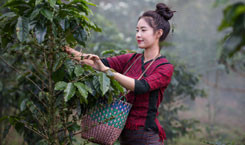Asian Coffees
Different countries in Asia started producing the most diverse varieties of coffee many centuries ago. Often most of the Asian coffees are summarized and generalized because a lot of the cheap coffee, the rest of the world uses for instant products and such, is being produced in Asia. Even though Asia does feature too many remarkable coffees, only the Asian production of cheap Robusta beans has a quantitative relevance for the world market.
For interested people, lifting the curtains of prejudice, Asia and some countries not normally associated with Asia, can surprise curious coffee-lovers with many diverse coffees of the finest qualities.
The most important coffee countries of Asia are India, China, Papua New-Genia, Australia, Vietnam and many of the thousands of Indonesian islands.
India
Even though India recently developed its very own coffee culture and produces ever-multiplying amounts of coffee, the large country is mainly known for its tea. India’s and especially Sri Lanka’s vast and incredibly pretty tea plantations are world famous.
The best-known coffee of India is the so-called monsoon coffee, even known in Europe. Back in the day, the colonial trade companies took months to ship their raw coffee beans from India to Europe and often faced the difficult and moist monsoon climate of India. During the storage of the raw coffee beans inside the hot and moist belly of the cargo ships, a slow fermentation process began, eventually noticeably altering the taste and aroma of the coffee beans by the time they arrived in Europe. The descriptions of this slowly fermented coffee vary and not everyone likes it, but many people value its mild acidity. Even though, the transport today doesn’t face these difficulties anymore because ships are faster and able to stock their bulk good in dry conditions, artificially fermented „monsoon coffee“ is a popular Indian variety.
India has a large variety of climate conditions and a lot of land mass. With growing success, they produce coffee beans of mentionable quality and today, even Starbucks is offering Indian beans. Giving India’s black gold a go is definitely worth it.
China
Just like India, China primarily represents a tea county. But just along with other countries, a couple of decades ago, the Americanization of China started and is progressing constantly, causing coffee to become a trendy thing to drink and making the brown beans more and more popular. Two decades ago, everything that was considered popular in the „western world“ started becoming popular in China too. Statistically seen, the averaged Chinese person only drinks about three cups of coffee per year but the demand is growing with the middle class and the people who can afford coffee.
Because of this development, a lot of Chinese farmers are now switching from tea to coffee production, hoping to earn more money and escape the often poor conditions, Chinese farmers often have to endure. At the moment, the coffee sector of China is growing 16% annually. Experts even estimate the demand for coffee to double until 2020. Because most of the Chinese farmers don’t have any experience with farming coffee nor the access to the necessary expertise, these local Chinese coffees often lack the quality to be exported. The bigger part of the Chinese coffee is bought by large corporations and turned into instant coffee for the domestic market.
Today, Chinas coffee production is at its beginning. But with a bit of practice and aid from more experienced nations, the Chinese farmers will soon be able to utilize the countrie’s perfect climate conditions to make excellent coffee.
Vietnam
Even though Vietnam is not exactly a large country compared to Brazil, Vietnam is the second largest coffee producer in the world, right after Brazil. Interestingly, the coffee culture is young in Vietnam. After the Vietnam war, the German Democratic Republic made itself strong for the communist country and world bank funds were directed to the country for reconstruction and development. One of their ways to reestablish a healthy economy was coffee.
Robusta, sometimes of questionable quality, is the best-known coffee of Vietnam. Just like the Name of the Robusta beans, originating from the coffea canephora plant, suggests, these plants are a lot more robust and less demanding than their more successful sibling coffea arabica. For the reconstruction of the war-ridden country, this was a big advantage. Even the most inexperienced farmers were able to quickly produce more or less drinkable coffee in almost any part of the country.
Robusta makes up for about 90% of today’s coffee production in Vietnam. The rest consists of arabica beans from the tropical plateaus and mountains. Some of these areas produce excellent arabicas and other specialty coffees because the conditions for growing coffee are almost perfect in Vietnam. Most of the coffee produced in Vietnam is exported and processed into capsules, pads and instant coffee.
The traditional way of making Vietnamese coffee is known all around the world. They brew a strong, really strong Robusta filter coffee and mix it with thick condensed milk and sugar. This beverage is served in a little plastic bag with a straw because in Vietnam, plastic or paper cups are too expensive.
Thailand
Thailand is one of the comparatively still very young countries producing coffee.
From opium to coffee
It all began in the 1970s, because the government at the time launched an initiative to this end. In the north of Thailand is the former "Golden Opium Triangle". The aim of the government was to offer the opium farmers an alternative for their livelihood. The small mountain people of the Akha, still living very traditionally, are at home in the village DOI CHAANG. A coffee plantation was established there with the help of the UN and the Thai Royal Court.
Environment and coffee cultivation in harmony
Particularly noteworthy is the clever and ecologically sensible implementation of the project. The existing forest was not cleared and replaced by large coffee plantations in monoculture, but the old tree population was integrated. Large shade-giving trees of various species form a symbiotic system with the coffee plants. Even areas already deserted by overexploitation were first afforested with fruit trees and then supplemented with coffee plants. This is an ideal way of growing coffee, which increases the resistance of the coffee plant against weather, diseases or pests due to the variety of different useful plants.
The beautiful mountain slopes of Thailand are situated at an altitude of 1,500 to 1,700 m. The climate is consistently mild and subject to only small temperature fluctuations. Climatic conditions in which the Arabica bean feels extremely well and rewards the coffee farmers with the best yields. Harvesting is done exclusively by hand. Only opitmal fully ripe coffee cherries are picked from mid-November to mid-March. The cooperative works according to a self-developed quality management system that comprises almost 50 defined work steps. This includes the cultivation of the plant, harvesting, washing, and drying and also the storage of the coffee. Today Thailand is one of the 20 largest coffee producers and the Arabica variety DOI CHAANG is one of the highest quality beans in the world.
Characteristics DOI CHAANG Arabica beans
Balanced, harmonious coffee, which is mild but still expressive and complex in taste. A combination of exotic fragrance flanked by slightly spicy aromas. Freshly baked bread, pistachio, cocoa and caramel create a multi-faceted bouquet. A slightly sparkling acidity rounds off the taste experience. On the palate mild, creamy and full.
ORO Caffe is the only roaster in Italy to use this excellent variety in ORO Caffe DOI CHAANG.
Beyond Fair Trade
Fair trade is a good start, but just a beginning. Beyond Fair Trade goes far beyond the payment of a higher coffee price. Thai entrepreneur and visionary Wicha Promyong and Canadian businessman John Darch made it possible for a mountain tribe plagued by poverty and contempt in a remote village in Thailand to become internationally famous for their DOI CHAANG coffee. They created the framework to integrate a remote location into a global trade for boutique coffee from an ethical source.
The uneducated and poor mountain tribe of the Akha, who were dependent on drug dealers and destroyed their own habitat by deforestation, found their way to freedom. A culturally traumatized people manages the successful transformation from opium poppy cultivation to the harvest of a stimulating, globally popular crop.
The story of the Doi Chaang Coffee Company helps conscientious coffee drinkers to imagine fairer trade models that go beyond fair trade. The cooperative reinvests all the money to improve the living conditions of the local community. A project that I hope will be a success.
Indonesia
Indonesia consists of thousands of little, tropical islands. A lot of these offer perfect climatic conditions for the production of excellent coffee. Colonialists from the Netherlands first brought arabica plants to Indonesia in the 17th century.
Even though, Indonesia still is the fourth largest coffee producing country in the world, a couple of decades ago the local farmers had to accept a huge setback when the majority of the country’s coffee plants died from a plague. Since then, most of the farmers switched their production to Robusta beans. The Robusta-carrying coffee plants offer higher resistance to diseases and vermin.
Unfortunately, a lot of the Robusta produce is of medium to low quality and mostly processed into instant coffee or other, cheap coffee products. Yet, Indonesia does have some high-quality varieties too. World-famous is the full-bodied „Mandheling“ Arabica from Sumatra as well as the „Kopi Luvac“ coffee that is eaten and dropped out by Indonesian wild cats.

